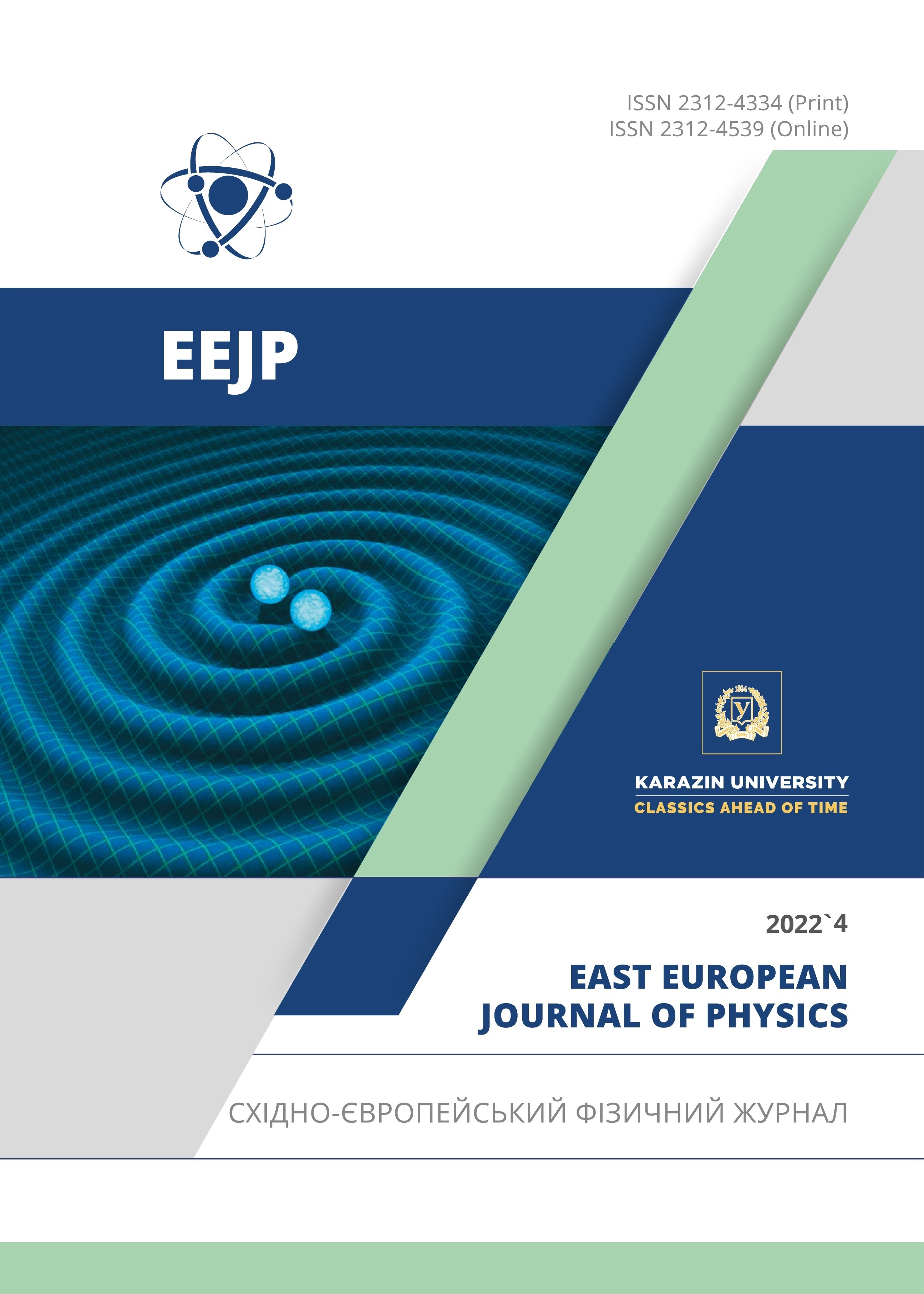A Demonstration Bench for Representing the Character of Phase Transitions of the First and Second Kind
Abstract
The paper presents the description of a demonstration bench, which includes a mathematical model and analysis tools for understanding the features of phase transitions of the first and second kind. The advantage of this demonstration bench is the rejection of all phenomenology and the obvious limitation of the application of various approximations and hypotheses. The description is formed on the well-known equations of hydrodynamics, which are well-tested and are a reliable basis for the construction of realistic models. The Proctor-Sivashinsky model, which was used to describe the process of convection development in a thin layer of liquid with poorly conductive heat boundaries, is the basis for the demonstration bench. Exactly this model allows to observe phase transitions of the first and second kind. The feature of the model is that it allocates one spatial scale of interaction, leaving for the evolution of the system the possibility to choose the nature of symmetry. All spatial disturbances of the same size but of different orientation interact with each other. This allows us not to distract from the main task of this work, which is to demonstrate the process of structure formation as a result of a cascade of phase transitions. The mechanism of phase transitions associated with the presence of minimums of the interaction coefficients of modes of the spectrum of the instability. There are a large number of structural defects, which appear as attributes of phase transition. The instability spectrum modes interference is the reason of the high rate of correlations in the propagation of a new phase.
Downloads
References
J. Chapman, and M.R.E. Proctor “Nonlinear Rayleigh-Benard convection between the poorly conducting boundaries”, J. Fluid Mech. 101, 759 (1980). https://doi.org/10.1017/S0022112080001917
V. Gertsberg, and G.E. Sivashinsky, “Large cells in nonlinear Rayleigh-Benard convection”, Prog. Theor. Phys. 66, 1219 (1981). https://doi.org/10.1143/PTP.66.1219
B.A. Malomed, A.A. Nepomnyashchy, and M.P. Tribelsky, “Twodimensional quasiperiodic structures in nonequilibrium systems”, ZhETF, 96, 684 (1989).
J.V. Swift, and P.C. Hohenberg, “Hydrodynamic fluctuations at the convective instability”, Phys. Rev. A, 15, 319 (1977). https://doi.org/10.1103/PhysRevA.15.319
M.I. Rabinovich, A.L. Fabrikant, and L.S. Tsimring, “Finite Dimensional Disorder”, UFN, 162(8), 1–42 (1992).
E.V. Belkin, I.V. Gushchin, A.V. Kirichok, and V.M. Kuklin, “Structural transitions in the Proctor-Sivashinsky model”, PAST, 68, 296 (2010). (in Russian). https://vant.kipt.kharkov.ua/ARTICLE/VANT_2010_4/article_2010_4_296.pdf
I.V. Gushchin, A.V. Kirichok, and V.M. Kuklin, “Pattern Transitions in Unstable Viscous Convective Medium”, https://doi.org/10.48550/arXiv.1311.3884
I.V. Gushchin, А.V. Kirichok, and V.M. Kuklin “Pattern formation in convective media”, «Journal of Kharkiv National University», physical series «Nuclei, Particles, Fields», 1040(1), 4-27 (2013). http://nuclear.univer.kharkov.ua/lib/1040_1(57)_13_p04-27.pdf
I.V. Gushchin, A.V. Kirichok, and V.M. Kuklin, “Pattern formation in unstable viscous convective medium”, PAST, 4, 251 (2013). https://vant.kipt.kharkov.ua/ARTICLE/VANT_2013_4/article_2013_4_251.pdf
I.V. Gushchin, A.V. Kirichok, and V.M. Kuklin, “Structural-phase transitions and state function in unstable convective medium”, PAST, 4, 252 (2015). https://vant.kipt.kharkov.ua/ARTICLE/VANT_2015_4/article_2015_4_252.pdf
I.V. Gushchin, A.V. Kirichok, and V.M. Kuklin, “State function in unstable convective medium”, East Eur. J. Phys. 2(1), 32 (2015). https://periodicals.karazin.ua/eejp/article/view/2811/2550
I.V. Gushchin, and V.M. Kuklin, “Structural phase transition in thin convection at dependence of viscosity on temperature”, PAST, 4, 256 (2018). https://vant.kipt.kharkov.ua/ARTICLE/VANT_2018_4/article_2018_4_256.pdf
I.V. Gushchin, V.M. Kuklin, and E.V. Poklonskiy, “Phase transitions in convection”, East Eur. J. Phys. 4, 34-40 (2019). https://doi.org/10.26565/2312-4334-2019-4-03
V.M. Kuklin, Selected chapters (theoretical physics), (V.N. Karazin KhNU, Kharkiv, 2021). pp. 244. http://dspace.univer.kharkov.ua/handle/123456789/16359
L. Pismen, “Inertial effects in long-scale thermal convection”, Phys. Lett. A, 116, 241–243 (1986). https://doi.org/10.1016/0375-9601(86)90141-6
A.V. Kirichok, V.M. Kuklin, I.P. Panchenko, S.S. Moiseev, and L.M. Pismen, “Dynamics of large-scale vortices formation in regime of convective instability”, in: International Conference “Physics in Ukraine”, (Bogolyubov Institute of Theor. Phys., Kiev, 1993), pp. 130 135. https://inis.iaea.org/collection/NCLCollectionStore/_Public/25/076/25076395.pdf
A.V. Kirichok, V.M. Kuklin, and I.P. Panchenko, “On the possibility of dynamo mechanism in a nonequilibrium convective medium”, Reports of NASU, 4, 87–92 (1997). (in Russian)
A.V. Kirichok, and V.M. Kuklin, “Allocated Imperfections of Developed Convective Structures”, Physics and Chemistry of the Earth Part A, 6, 533–538 (1999). https://www.sciencedirect.com/science/article/abs/pii/S1464189599000678
S.S. Moiseev, K.R. Oganesyan, P.B. Rutkevich, A.V. Tur, G.A. Khomenko, and V.V. Yanovskiy, “Vortex dynamo in spiral turbulence”, in: Integrability and kinetic equations for solitons, edited by V.G. Bar'yakhtar, V.E. Zakharova, and V.M. Chernousenko. Sat. scientific. (in Russian), http://smiswww.iki.rssi.ru/files/publications/rutkevich/jetf_1988_2_94.pdf
I.V. Gushchin, V.M. Kuklin, O.V. Mishin, and O.V. Priymak, “Model of physical processes due of CUDA technology”, (V.N. Karazin KhNU, Kharkiv, 2017), pp. 116. (in Ukrainan). https://cutt.ly/UMH5G8f
Copyright (c) 2022 Ivan V. Gushchin

This work is licensed under a Creative Commons Attribution 4.0 International License.
Authors who publish with this journal agree to the following terms:
- Authors retain copyright and grant the journal right of first publication with the work simultaneously licensed under a Creative Commons Attribution License that allows others to share the work with an acknowledgment of the work's authorship and initial publication in this journal.
- Authors are able to enter into separate, additional contractual arrangements for the non-exclusive distribution of the journal's published version of the work (e.g., post it to an institutional repository or publish it in a book), with an acknowledgment of its initial publication in this journal.
- Authors are permitted and encouraged to post their work online (e.g., in institutional repositories or on their website) prior to and during the submission process, as it can lead to productive exchanges, as well as earlier and greater citation of published work (See The Effect of Open Access).








